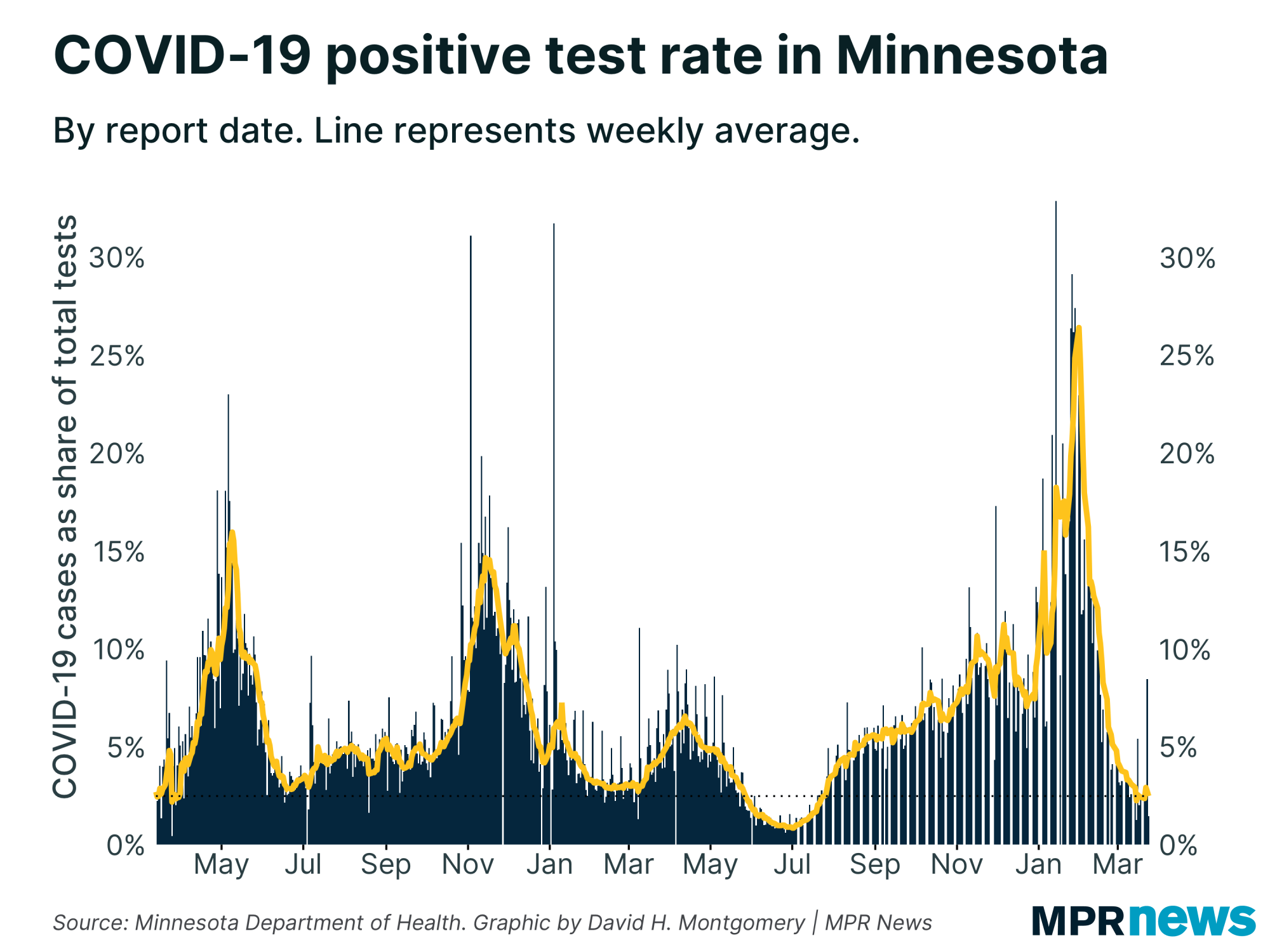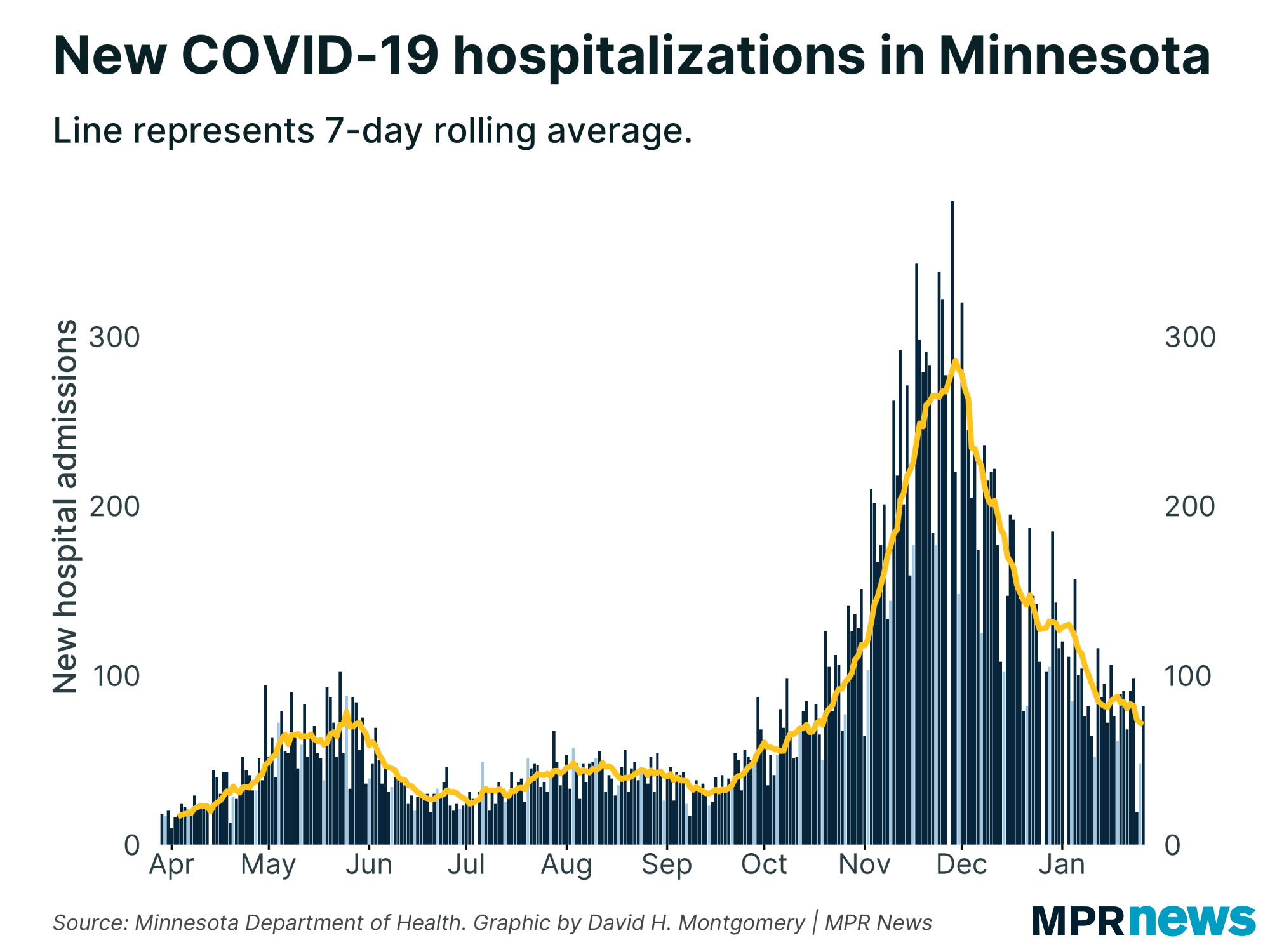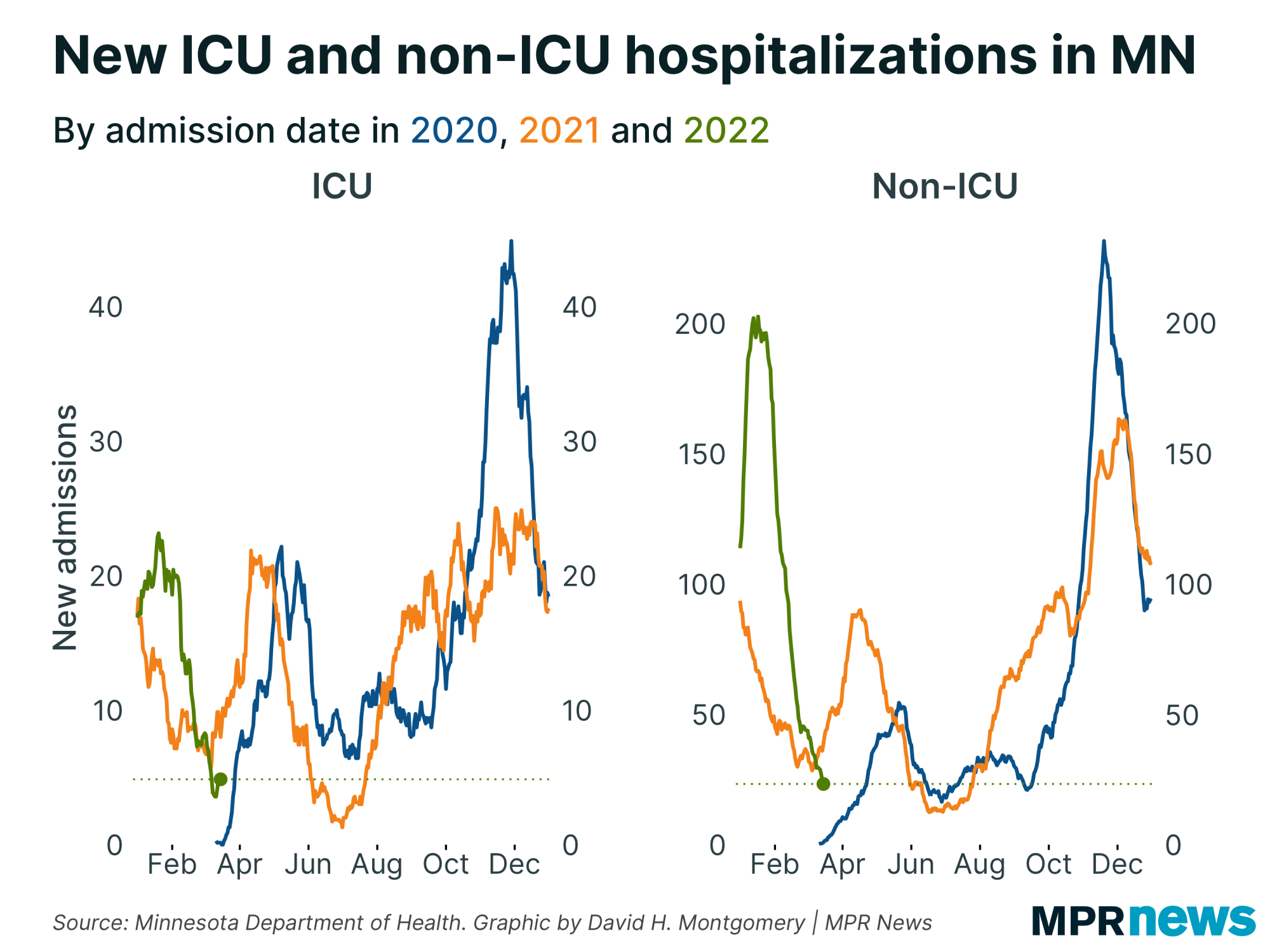Oct. 31 update on COVID-19 in MN: Another day with 3,000+ new cases

Go Deeper.
Create an account or log in to save stories.
Like this?
Thanks for liking this story! We have added it to a list of your favorite stories.
Updated: 11:25 a.m.
Minnesota health officials reported 3,021 new COVID-19 cases in the state on Saturday — the second day in a row that the state exceeded 3,000 new cases as Minnesota saw 20 more deaths from COVID-19, and the number of new hospitalizations hit a record high.
Saturday’s case increase is the second-highest on record in Minnesota, trailing only the 3,165 cases reported the previous day.

The average test positivity rate over the past week climbed to 9.5 percent — well above the 5-percent level state officials have said is a critical threshold in policy decisions. The test positivity rate stood at about 4.6 percent at the start of October.

The 20 deaths reported Saturday included 15 residents of long-term care facilities. Two of the deaths were residents of Hennepin County — bringing the county’s COVID-19 death toll to 1,000.
Turn Up Your Support
MPR News helps you turn down the noise and build shared understanding. Turn up your support for this public resource and keep trusted journalism accessible to all.
The average daily death toll over the past week is 18, double what it was to start the month.
The Minnesota Department of Health reported 151 new COVID-19 hospitalizations on Saturday, a record daily increase; the previous record was 141, set earlier in the week.
The average daily increase in hospitalizations over the past week is 118 — up from 60 at the start of October.

Here are Minnesota’s current COVID-19 statistics:
2,457 deaths (20 new)
148,472 positive cases (3,021 new); 127,362 off isolation
2,839,304 tests; 1,853,617 people tested (about 33 percent of the state’s population)
9.5 percent seven-day positive test rate (officials find 5 percent concerning)
The number of people hospitalized in Minnesota because of COVID-19 also rose Friday to an all-time high: 738 in the hospital, with 176 needing intensive care.

The rampant spread is being driven now by the “thousands of seemingly small decisions” Minnesotans make daily to meet and gather with others without wearing masks, socially distancing or taking other steps to stem the spread, state Health Commissioner Jan Malcolm told reporters this week.
Pretty much every graph drawn this week on COVID-19 holds a trend line going in the wrong direction: up.

Caseloads rising across age groups
New cases are up dramatically over the past month in all age groups.
People in their 20s still make up the age bracket with the state’s largest number of confirmed cases — more than 32,500 since the pandemic began, including more than 18,100 among people ages 20-24.

The number of high school-age children confirmed with the disease has also grown, with more than 12,900 total cases among children ages 15 to 19 since the pandemic began.
Those numbers help explain why experts remain particularly concerned about teens and young adults as spreaders of the virus.
While less likely to feel the worst effects of the disease and end up hospitalized, experts worry youth and young adults will spread it to grandparents and other vulnerable populations. It’s especially concerning because people can have the coronavirus and spread COVID-19 when they don’t have symptoms.

That led Gov. Tim Walz on Wednesday to urge testing Minnesotans ages 18 to 35, a group he says is driving much of the asymptomatic virus spread.
"We want them to get tested so they can then know if they're infected so they can isolate,” added Dan Huff, an assistant state health commissioner. “That will help us stop that source of transmission in an area we just see as a major reservoir for the disease spreading out through the state."
Cases surging along Minnesota’s western border
Regionally, central and northern Minnesota have driven much of the recent increase in new cases while Hennepin and Ramsey counties show some of the slowest case growth in the state.
Newly reported cases are highest in northwestern Minnesota. The data doesn’t explain why. However, cases are surging currently in the Dakotas. North Dakota and South Dakota, however, have the country’s worst per-capita spread rates.

Collectively, rural areas of Minnesota continue to report the most new COVID-19 cases.
Northern Minnesota, once the region least affected by the disease, has also seen its caseload grow dramatically in recent weeks.
Western and northwestern Minnesota continue to see cases rise swiftly relative to it population.

“We are seeing more deaths in greater Minnesota because we are seeing more cases there,” Kris Ehresmann, the state’s infectious disease director, said last week. “We will see more and more deaths from greater Minnesota because of the high caseload.”
Latino, Indigenous cases jump
In Minnesota and across the country, COVID-19 has hit communities of color disproportionately hard in both cases and deaths.
Minnesotans of Hispanic descent are testing positive for COVID-19 at about five times the rate of white Minnesotans. They, along with Black Minnesotans, are also being hospitalized and moved to intensive care units at higher rates than the overall population.

Similar trends hold true for Minnesota’s Indigenous residents. Counts among Indigenous people have jumped in October relative to population. The number of new COVID-19 cases among Native Americans has grown by about 75 percent in recent weeks.
October data also show newly confirmed cases accelerating among Latino people in Minnesota.
Distrust of the government, together with deeply rooted health and economic disparities, have hampered efforts to boost testing among communities of color, particularly for unauthorized immigrants who fear their personal information may be used to deport them.
Spread threatens to swamp ‘flood walls’
Unlike earlier in the pandemic, health authorities believe the current outbreaks are being driven more by people letting their guard down at family gatherings and celebrations, sporting events and informal meetups rather than at stores, restaurants and bars.
Officials had expected that late summer and early fall gatherings would bring a surge of cases in October. They also anticipated the wave would put more people in the hospital — and lead to more deaths. That’s come to pass.
The current wave is especially worrisome because the state’s seeing cases rise again in long-term care facilities, where some of the state’s most vulnerable people live.
Despite efforts to protect those facilities, Minnesota saw 186 new cases in long-term care on Tuesday alone, said Ehresmann.
Many of these cases are due to community spread — health care workers getting infected outside the facilities and then bringing it in. “Even with the flood walls we built up, if the waters rise high enough, we’ll still have big problems,” Ehresmann said Thursday.
Some events ‘no longer safe’
The newest numbers come two days after Walz and public health experts painted an increasingly worrisome picture of a COVID-19 outbreak now driven more by people letting their guard down at family gatherings and celebrations, sporting events and informal meetups rather than at stores, restaurants and bars.
The governor’s top health officers again urged Minnesotans to rethink their plans for large family gatherings at Thanksgiving and other upcoming holidays, warning they pose a rising risk.
Given the current high levels of community spread in Minnesota and the Upper Midwest, get-togethers of “large extended families, multiple families from around the region, that absolutely would be a really, really bad idea this year,” Ehresmann said Monday.
There have been more than 70 related outbreaks from weddings since June, and that's lead to more than 674 direct cases among those attending, and one death, Malcolm said Wednesday.
The “vast majority” of COVID-19 spread is coming from these kinds of events, said Ehresmann. “Things that were relatively safe a month or two ago are no longer safe."
Ehresmann reiterated that point Wednesday as she cautioned Minnesotans against attending big Halloween parties and other events outside of a person’s immediate household. That kind of fun, she said, "is riskier now than it was a month ago.”
Developments around the state
Surge has dire impacts on Mayo’s NW Wisconsin system
Mayo Clinic's northwest Wisconsin system is halting elective procedures as COVID-19 cases and hospitalizations surge.
Hospital officials say they're going to shift staff and beds to handle COVID-19 patients.
In the last week, the region's COVID-19 hospitalization load has doubled from 35 to 70. It’s the highest COVID-19 case load in the entire Mayo system.
Regional administration leader Jason Craig said a combination of high case counts, hospitalizations and limited staff have created a dire situation.
"What you saw on the news earlier this year in the spring in place like New York City, that's happening in the Chippewa Valley right now," he said.
More than 230 staff in the system are out because of COVID-19, he said, either because they have tested positive or because they are quarantining after being exposed. Craig said many of these cases are the result of community transmission.
Minnesota's cases continue their ascent as well, with more than 3,100 new cases reported Friday, a daily record.
— Catharine Richert | MPR News
Polling places in MN cities along the Mississippi get masks for Election Day
Thousands of masks have been shipped to polling places along the entire length of the Mississippi River, including cities in Minnesota.
Leaders at the Mississippi River Cities and Towns Initiative coordinated and paid for the PPE deliveries. They say because of dwindling city revenue during the pandemic, some communities can’t afford election day safety measures on their own.
Red Wing, Minn., Mayor Sean Dowse said the city has been cutting taxes and forgiving fees, trying to keep the local economy afloat, so there’s not much money left over for protective gear.
“Minnesota is dealing with a long gradual rise in contagion, it’s really taxing our resources. In my county, Goodhue, new cases have peaked just this last week, and may continue and upward trend for the next few weeks,” Dowse said.
He said the masks will be given mostly to voters arriving at the polls without their own protective gear. Dowse said he hopes the additional gear will help blunt the spike in COVID-19 cases Minnesota has seen this week.
— John Enger | MPR News
Top headlines
State plans to launch COVID-19 testing effort among young adults: Those between the ages of 18 to 35 represent the largest number of new cases in Minnesota right now — and Gov. Tim Walz said people within that age group who are infected with COVID-19 but don’t have any symptoms are driving much of the virus’ spread in the state.
Pandemic may add to misery of seasonal affective disorder, but strategies can help: Those used to struggling with seasonal depression have plans for how to feel better during the pandemic in winter.
5 tips — and a bunch of ideas — to help you celebrate Halloween safely this year: Many traditional Halloween traditions, like trick-or-treating, involve face-to-face interactions with lots of different people. But this year, in order to prevent the spread and protect each other from COVID-19, some parts of Halloween may need a little updating.
COVID-19 in Minnesota
Data in these graphs are based on the Minnesota Department of Health's cumulative totals released at 11 a.m. daily. You can find more detailed statistics on COVID-19 at the Health Department website.


